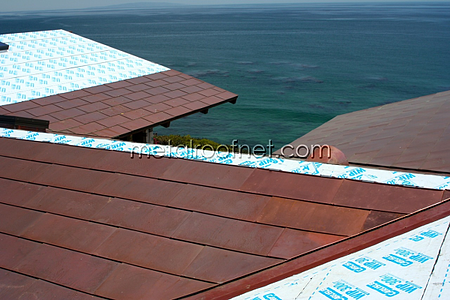 People asking us about the “best" metal roof or the “best gauge” for a metal roof probably get a more complicated answer than they were expecting. The truth is complex, because when it comes to metal roofing, different gauges work best for different metals, and the same is true for different profiles and applications. Higher-end projects with a tougher spec and very steep roofs or vertical walls are usually handled best by the heaviest gauges. Thinner gauges will often be found on low-end projects, including agricultural and exposed fastener jobs.
People asking us about the “best" metal roof or the “best gauge” for a metal roof probably get a more complicated answer than they were expecting. The truth is complex, because when it comes to metal roofing, different gauges work best for different metals, and the same is true for different profiles and applications. Higher-end projects with a tougher spec and very steep roofs or vertical walls are usually handled best by the heaviest gauges. Thinner gauges will often be found on low-end projects, including agricultural and exposed fastener jobs.Metal gauge gets higher as the metal becomes thinner, just like sewing needles. That means a 22 gauge (or 22GA) metal roof might be nearly twice the thickness of a 29 gauge (29GA) metal roof. And to make things even more complicated, different metals have their own measuring standards, which means a 24 gauge copper roof panel is a different thickness than a 24 gauge steel roof panel.
 At Metal Roof Network, we rarely make our profiles in gauges thinner than 26 gauge steel. In fact, most of our products are 24 gauge and heavier. If your project simply needs to meet “minimum” thickness, 26 or 28 are typical choices.
At Metal Roof Network, we rarely make our profiles in gauges thinner than 26 gauge steel. In fact, most of our products are 24 gauge and heavier. If your project simply needs to meet “minimum” thickness, 26 or 28 are typical choices.
If a better quality installation with long-term appearance and resistance to extreme weather is the goal, you should consider 24GA and heavier.
You'll also need to remember that the roof's profile will also affect suitability of metal gauges. Try this little experiment to get a better understanding:
- Hold a piece of printer paper between your fingers so it hangs down toward your desk.
- Slowly lower the paper onto the desk and see if it will support itself. Spoiler - it's simply going to collapse flat onto the table.
- Now take that same piece of paper and put two or more folds down the length, and try the same thing again.
- Voila - the paper supports itself because you’ve “added” strength by creating the folds.
As you shop and compare metal roof prices, keep this understanding about metal gauges in mind. Two roofs that look the same may acutally have completely different thicknesses of metal. In almost every case given the same metal, the heavier gauge material will be stronger, more wind resistant, more resilient to foot traffic, and it will last longer, too.
If you have a metal roof project in the near future and need help specifying and sourcing the best version for your job, we can help you select the best type and gauge of metal roof for your job. Call or contact us today.



